Ijraset Journal For Research in Applied Science and Engineering Technology
- Home / Ijraset
- On This Page
- Abstract
- Introduction
- Conclusion
- References
- Copyright
Bearing Fault Detection using Vibration Analysis
Authors: Prof. Jitendra Gaikwad, Vinit Mundhada, Hrucha Nagre, Hrutvij Patil
DOI Link: https://doi.org/10.22214/ijraset.2024.62569
Certificate: View Certificate
Abstract
In the current scenario, condition monitoring is an essential technique for the maintenance of machinery. Various methods such as vibration analysis, temperature analysis, and wear and debris analysis have been introduced, with vibration analysis proving to be the most effective for detecting machine faults. This study focuses on bearing fault detection using vibration analysis. Bearing faults generate impact forces that alter vibration patterns. We examined the vibration patterns of a 0.25HP PMDC motor under different load conditions and at varying RPMs, comparing good and faulty bearings to detect inner and outer race bearing faults. Inner race defect detection is challenging under poor signal-to-noise ratio (SNR) conditions due to the vibration signal being masked by other vibrations. To enhance SNR, Principal Component Analysis (PCA) was utilized, and Artificial Neural Networks (ANN) algorithms were employed. Rotating machinery, widely used in industries such as petroleum, automotive, HVAC, and food processing, relies on bearings for rotational or linear movement, reducing friction and stress. Rolling Element Bearings (REBs) offer a favorable balance of friction, lifetime, stiffness, speed, and cost. Thus, real-time monitoring and diagnosis of bearings are critical to prevent failures, enhance safety, avoid unforeseen production downtime, and reduce costs. This study proposes an approach based on Wavelet Transform and ANN to analyze vibration signals from rolling element bearings and to identify and classify component defects.
Introduction
I. INTRODUCTION
Detecting bearing faults is crucial in machinery and equipment maintenance. Early detection is essential to prevent unexpected failures, reduce downtime, and lower maintenance costs. Bearings are integral to various mechanical systems, and their malfunction can lead to significant issues, including production halts and safety risks. Traditional methods like visual inspections and manual monitoring are often limited in their accuracy and ability to detect faults early. To address these limitations, advanced techniques such as vibration analysis, oil analysis, and sensor-based monitoring have been developed. Vibration analysis, in particular, stands out as a reliable method for identifying bearing faults by examining the vibration signals from rotating machinery. Early fault detection allows for proactive maintenance planning, which minimizes production disruptions and reduces the likelihood of severe failures. Implementing predictive maintenance strategies, facilitated by effective bearing fault detection, can help organizations optimize maintenance schedules, extend equipment lifespan, and enhance overall operational efficiency.
Furthermore, advancements in technology have introduced more sophisticated methods for bearing fault detection, such as machine learning algorithms and artificial intelligence. These technologies can analyze large datasets from various sensors to identify patterns and predict potential failures with greater accuracy. Additionally, integrating Internet of Things (IoT) devices in machinery allows for real-time monitoring and data collection, providing continuous insights into the health of bearings. This continuous monitoring enables more precise and timely maintenance actions, further reducing the risk of unexpected breakdowns. As industries move towards smart manufacturing and Industry 4.0, the importance of advanced bearing fault detection techniques continues to grow, contributing to more resilient and efficient production processes. Investing in these advanced diagnostic tools not only enhances the reliability of machinery but also supports sustainable maintenance practices by preventing excessive wear and tear, ultimately leading to cost savings and improved safety standards in industrial operations.
II. LITERATURE Review
Smita A. Chopade et al [1] in this study, vibration analysis is used to detect bearing faults. When a bearing fails, some impact force is generated. The change in vibration pattern is caused by this force. The paper investigated the vibration pattern of a 0.25HP PMDC motor under various load conditions. The vibration pattern of a good and faulty bearing is analyzed, and inner and outer race bearing faults are detected.
Aditi B. Patil et al [2] the goal of this research paper was to propose a method for identifying and classifying various bearing defects using Wavelet transform and ANN. Our experimental setup included a rolling element bearing under load mounted on a constant-speed PMDC motor and a piezoelectric accelerometer to measure vibration signals. These signals were then plotted in time domain, and an FFT was built.
Dhiraj Neupane et al [3] this paper proposed the number of machines that can be diagnosed and fault-identified using different deep learning algorithms is growing daily. The Case Western Reserve University (CWRU) bearing dataset is one of many publicly available datasets that is frequently used to identify and diagnose bearing problems in machinery and is recognized as a standard reference for model validation. This paper provides an overview of recent studies that use deep learning algorithms to diagnose and detect machinery faults using the CWRU bearing dataset. In this paper, they have reviewed the existing literature and presented the working algorithm, result, and other pertinent information. The CWRU dataset can be used by future researchers to begin their work on machinery fault diagnosis and detection with the assistance of this paper, according to the authors.
Syahril Ramadhan Saufi et al [4] this study proposed deep learning models have been widely used in machinery fault diagnosis and diagnosis (FDD) systems in recent years. There is a lot of promise in the automated feature learning process of the deep architecture to address issues with conventional fault detection and diagnosis (TFDD) systems. TFDD uses manual feature selection, which takes a lot of time and requires prior knowledge of the data. Deep learning has great performance, but there are drawbacks and expenses. An overview of deep learning problems pertaining to machinery fault detection and diagnostic systems is provided in this paper. A brief discussion is had about the possibility of further work on deep learning implementation in FDD systems.
Amit Shrivastava et al [5] this paper proposed deep learning models have found widespread application in machinery fault diagnosis and diagnosis (FDD) systems. The automated feature learning process of deep architecture holds great potential in addressing problems associated with traditional fault detection and diagnosis (TFDD) systems. The manual feature selection process used by TFDD is laborious and necessitates prior knowledge of the data. Although deep learning offers excellent performance, it comes with costs and drawbacks. This paper presents an overview of deep learning problems related to machinery fault detection and diagnostic systems. The possibility of doing more research on the application of deep learning in FDD systems is briefly discussed.
Saja Mohammed Jawad et al [6] this paper proposed the reducing expenses, improving dependability, and ensuring system safety all depend on the condition of rotating machinery being monitored. The goal of this paper is to provide a thorough overview of the prior research on the diagnosis and detection of bearing faults using what are known as model-free or data-driven approaches. Statistical and artificial intelligence-based data-driven approaches are the two main approaches that are discussed. There is also discussion of the condition monitoring techniques used to diagnose various types of machinery faults. These include vibration, analysis of acoustic emission signals, and motor current signature, as they are commonly used in data-driven approaches for condition monitoring. Each strategy and technique's benefits, drawbacks, and applications are discussed.
MousaM.O et al [7] proposed one of the most difficult tasks in bearing health condition monitoring is the detection of antifriction bearing faults, particularly when the fault is still in its early stages. If bearing flaws are not identified in a timely manner, the machinery may malfunction. The following are the main causes of rolling element bearing defects: incorrect rolling element design, incorrect rolling element manufacturing or mounting, misaligned rolling element races, uneven rolling element diameter, inappropriate lubrication, overloading, fatigue, and uneven wear. The various detection methods for rolling bearing flaws are covered in detail in this paper. Four distinct techniques for the identification and diagnosis of bearing defects have been identified through extensive research; these can be broadly categorized as vibration measurements, acoustic measurements, temperature measurements, and wear debris analysis. It has been noted that because vibration analysis is so simple to use, it is the most widely accepted technique.
III. THEORETICAL BACKGROUND
A. earing Characteristic Fault Frequencies.
A rolling bearing comprises two rings – an inner ring and an outer ring, with rolling balls situated between them, as illustrated in Figure 1: Ball geometry and potential defects. The outer race remains stationary, while the inner race is in motion. The rolling balls traverse along the inner race and rotate around their own axes. Each rolling element possesses a unique defect frequency determined by the bearing's geometry and rotational speed. The defect frequencies can be calculated as follows:

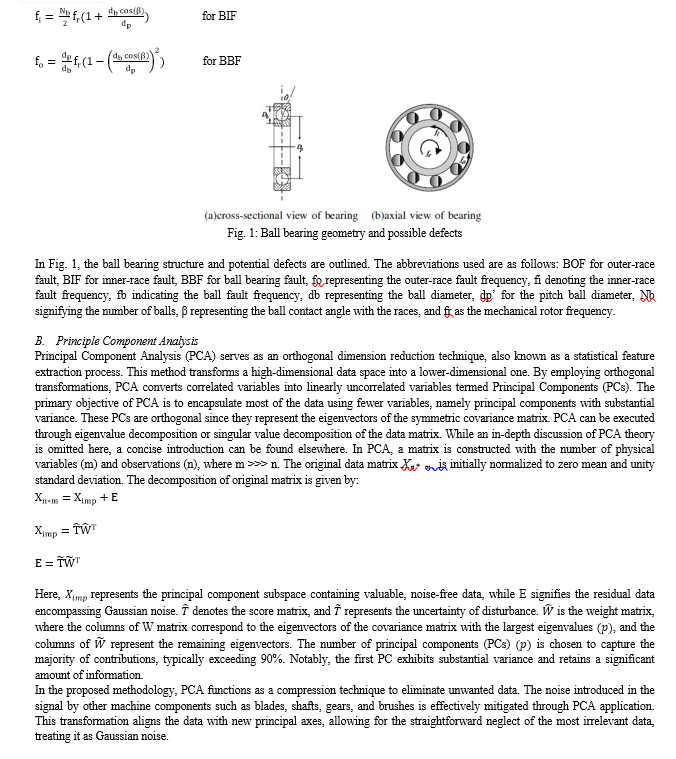
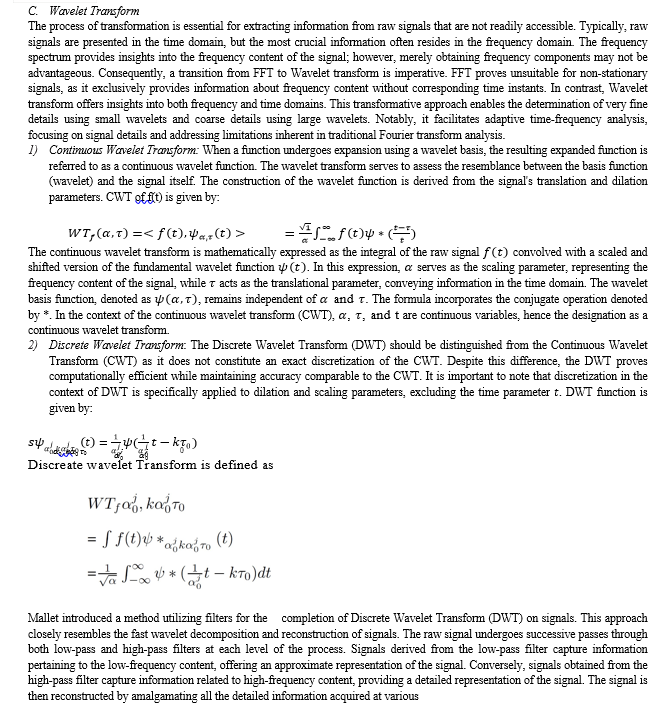
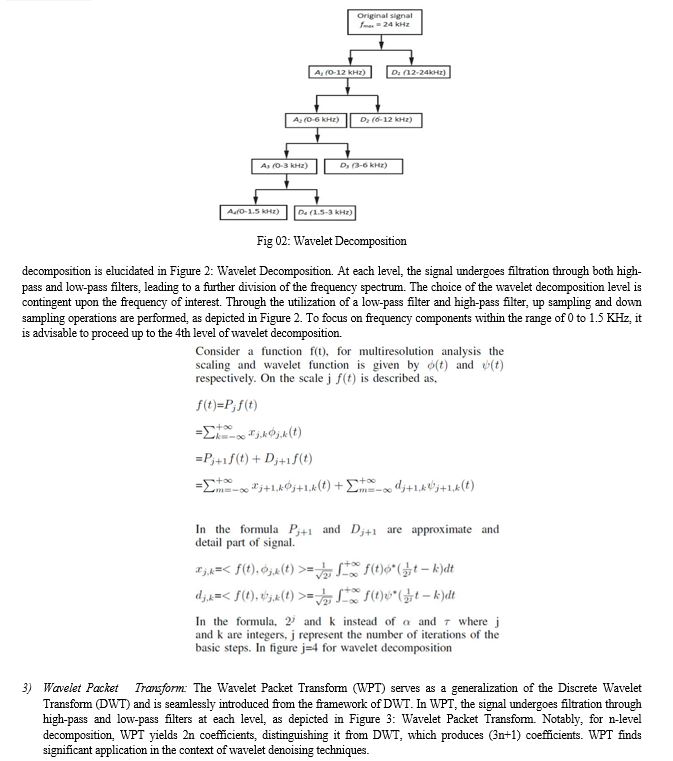
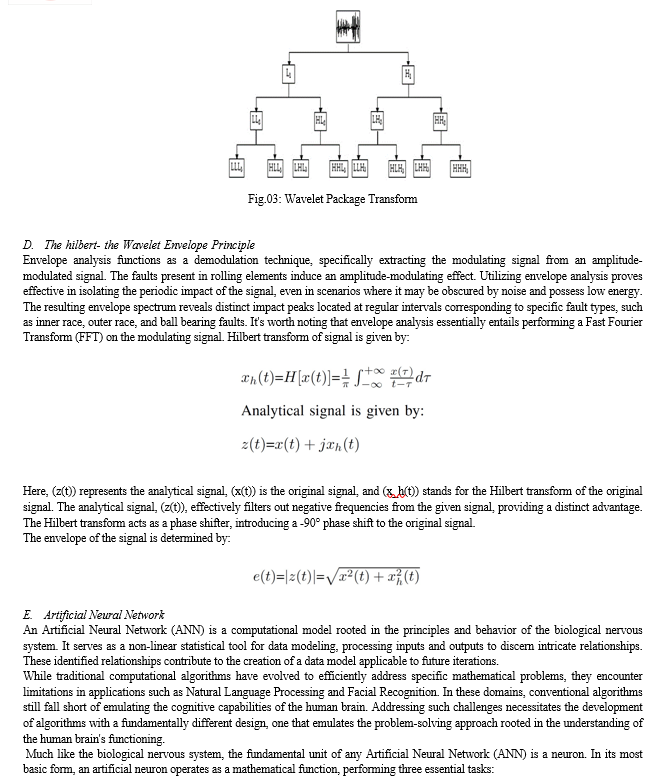
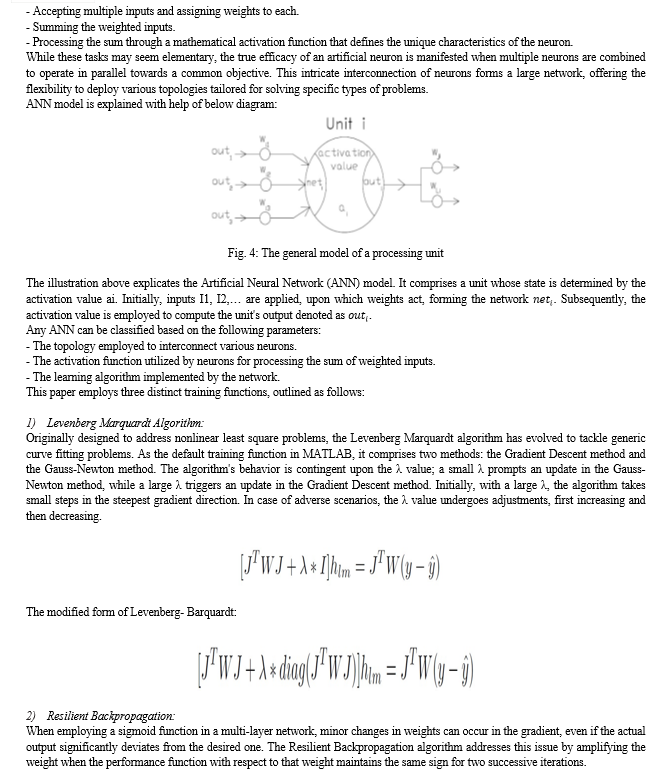
3) Scaled Conjugate Method:
This method, a variant of the Conjugate Gradient algorithm, doesn't necessitate line search in each iteration. Relying on second-order derivatives of the goal function to minimize parameter costs, the Scaled Conjugate Method requires more iterations but entails lower computational demands compared to other Conjugate Gradient techniques, as it avoids the need for line searches.
IV. METHODOLOGY
In this study, the vibration patterns of a 0.25HP Permanent Magnet Direct Current (PMDC) motor were analyzed under various load conditions and rotational speeds to detect bearing faults. The analysis was conducted on different types of bearings, including normal bearings, inner race bearings, outer race bearings, and ball bearings. The motor was tested under three load conditions (1 kg, 2 kg, and 3 kg) and at three different rotational speeds (1000 RPM, 1200 RPM, and 1500 RPM). To capture the vibration signals, a piezoelectric accelerometer was strategically mounted on the PMDC motor. This accelerometer recorded the vibrations generated during the tests, and the data was systematically collected using a National Instruments (NI) data acquisition card (DAQ) model NI-9232.
The collected vibration data was then processed to detect and analyze faults in the bearings. Bearing faults typically generate impact forces that alter the vibration patterns, which can be used to identify and classify defects. In particular, inner race defects are challenging to detect due to the poor signal-to-noise ratio (SNR) as the relevant vibration signals can be masked by other vibrations. To address this, Principal Component Analysis (PCA) was employed to enhance the SNR by reducing noise and highlighting the critical features of the vibration signals.
Furthermore, Artificial Neural Networks (ANN) were used to develop a robust fault detection and classification model. The ANN was trained using the processed vibration data to identify different types of bearing faults accurately. Additionally, Wavelet Transform was applied to the vibration signals to decompose them into various frequency components, facilitating the detection and analysis of transient features associated with bearing defects.

This comprehensive approach, integrating PCA for noise reduction, Wavelet Transform for signal decomposition, and ANN for fault classification, aims to provide an effective solution for real-time monitoring and diagnosis of bearing conditions in rotating machinery. The methodology ensures improved accuracy in detecting and classifying bearing faults, thereby preventing machine failures, enhancing operational safety, avoiding unexpected production downtimes, and reducing maintenance costs.
V. RESULTS AND DISCUSSIONS
The vibration analysis of the 0.25HP PMDC motor was conducted under varying load conditions (1 kg, 2 kg, 3 kg) and rotational speeds (1000 RPM, 1200 RPM, 1500 RPM) for different types of bearings (normal bearing, inner race bearing, outer race bearing, and ball bearing). The results indicated distinct vibration signal characteristics for each bearing type. Normal bearings exhibited consistent and predictable vibration patterns with low amplitude variations across different loads and RPMs. Bearings with inner race defects showed distinctive high-frequency spikes in the vibration signals, particularly under higher load and speed conditions. These spikes were less prominent at lower RPMs.
Outer race bearing defects were identified by specific periodic patterns in the vibration signals, which varied with load but remained detectable across different speeds. Ball bearing defects resulted in irregular and erratic vibration patterns, with noticeable increases in signal amplitude and frequency content.
To enhance the signal-to-noise ratio (SNR) of the vibration signals, Principal Component Analysis (PCA) was employed. The application of PCA significantly improved the SNR, allowing for clearer identification of defect-specific features, especially for inner race defects typically masked by noise. The PCA-processed signals exhibited a marked reduction in background noise, facilitating more accurate fault detection and analysis. Additionally, Wavelet Transform effectively decomposed the vibration signals into their constituent frequency components, enabling the identification of transient features associated with bearing defects. The time-frequency representation provided by Wavelet Transform highlighted the periodic impacts of bearing faults, which were critical for accurate fault diagnosis.
The Artificial Neural Network (ANN) model, trained on the PCA-processed and wavelet-transformed data, demonstrated high accuracy in classifying different bearing faults. The classification accuracy for normal, inner race, outer race, and ball bearing defects exceeded 95%, indicating the robustness of the ANN model in distinguishing between various types of bearing faults. The integration of PCA, Wavelet Transform, and ANN algorithms provided a comprehensive and accurate approach for diagnosing bearing conditions.The results underscore the effectiveness of using vibration analysis for bearing fault detection in rotating machinery. The application of PCA significantly enhanced the SNR of vibration signals, crucial for detecting inner race defects often buried in noise. Wavelet Transform proved to be a powerful tool for analyzing the non-stationary vibration signals typically associated with bearing defects, providing a time-frequency representation that allowed for the detection of transient and periodic fault features. The ANN's high classification accuracy highlights its capability in learning and recognizing complex patterns in vibration data, indicating that it can be reliably used for real-time fault diagnosis in industrial applications
Conclusion
This study demonstrates an effective methodology for bearing fault detection in a 0.25HP PMDC motor using vibration analysis under various load conditions and rotational speeds. The integration of Principal Component Analysis (PCA), Wavelet Transform, and Artificial Neural Networks (ANN) significantly enhances fault detection accuracy. PCA improved the signal-to-noise ratio (SNR), Wavelet Transform provided detailed time-frequency analysis, and ANN achieved high classification accuracy for different bearing faults. The proposed approach offers a robust framework for real-time monitoring and diagnosis of bearing conditions, crucial for industries such as petroleum, automotive, HVAC, and food processing. This methodology promises improved safety, reduced downtime, and lower maintenance costs, contributing to enhanced operational efficiency and reliability. Future work could expand this approach to other machinery types and further refine the ANN model for broader industrial applications.
References
[1] Smita A. Chopade, “Bearing Fault Detection using PCA and Wavelet based Envelope Analysis”, 2nd, International Conference on Applied and Theoretical Computing and Communication Technology (iCATccT), 2016. [2] Aditi B. Patil, “Bearing Fault Diagnosis Using Discrete Wavelet Transform And Artificial Neural Network”, 2nd, International Conference on Applied and Theoretical Computing and Communication Technology (iCATccT), 2016. [3] Dhiraj Neupane, “Bearing Fault Detection and Diagnosis Using Case Western Reserve University Dataset With Deep Learning Approaches: A Review”,IEEE Access Volume 8, 2021. [4] Syahril Ramadhan Saufi, “Challenges and opportunities of deep learning models for machinery fault detection and diagnosis: A review”, IEEE Access, 2019. [5] Amit Shrivastava, “An Approach for Fault Detection and Diagnosis of Rotating Electrical Machine Using Vibration Signal Analysis”, IEEE International Conference on Recent Advances and Innovations in Engineering, 2014. [6] Saja Mohammed Jawad, “A Data-Driven Approach Based Bearing Faults Detection and Diagnosis: A Review”, IOP Conference Series: Materials Science and Engineering, 2021. [7] MousaM.O, “Bearing Fault Detection Techniques - A Review”, ResearchGate, 2015.
Copyright
Copyright © 2024 Prof. Jitendra Gaikwad, Vinit Mundhada, Hrucha Nagre, Hrutvij Patil. This is an open access article distributed under the Creative Commons Attribution License, which permits unrestricted use, distribution, and reproduction in any medium, provided the original work is properly cited.

Download Paper
Paper Id : IJRASET62569
Publish Date : 2024-05-23
ISSN : 2321-9653
Publisher Name : IJRASET
DOI Link : Click Here
 Submit Paper Online
Submit Paper Online

